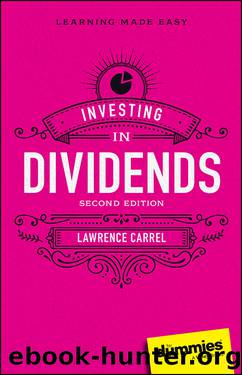Investing in Dividends for Dummies by Carrel Lawrence;

Author:Carrel, Lawrence; [Carrel, Lawrence]
Language: eng
Format: epub
Publisher: John Wiley & Sons, Incorporated
Published: 2023-07-28T00:00:00+00:00
You canât use any of these trading orders with a mutual fund.
Reducing your cost of ownership
Although some ETFs are actively managed, most equity ETFs are index funds (funds that are passively managed). Because index funds have low management costs, ETFs typically charge an expense ratio (the amount of the annual operating expenses) lower than almost all actively managed mutual funds. In addition, they usually charge less than comparable index-based mutual funds.
Table 6-1 shows the differences in expense ratios among mutual funds and ETFs. The first number is the asset-weighted average net expense ratio for all mutual funds, 1 percent, or one percentage point. That means you pay the fund $10 for every $1,000 invested you've invested in the fund. Meanwhile, the comparable number for ETFs is 0.57 percent, or $5.70 for every $1,000 invested. Active ETFs charge 0.72 percent versus active mutual funds fee of 1.01 percent.
TABLE 6-1 The Average Net Expense Ratio
Group
Expense Ratio
Download
This site does not store any files on its server. We only index and link to content provided by other sites. Please contact the content providers to delete copyright contents if any and email us, we'll remove relevant links or contents immediately.
| Analysis & Strategy | Bonds |
| Commodities | Derivatives |
| Futures | Introduction |
| Mutual Funds | Online Trading |
| Options | Portfolio Management |
| Real Estate | Stocks |
Rich Dad Poor Dad by Robert T. Kiyosaki(6175)
Pioneering Portfolio Management by David F. Swensen(6079)
How To Win Friends and Influence People by Dale Carnegie(4332)
The Money Culture by Michael Lewis(3846)
The Dhandho Investor by Mohnish Pabrai(3560)
The Wisdom of Finance by Mihir Desai(3523)
Liar's Poker by Michael Lewis(3221)
The Intelligent Investor by Benjamin Graham Jason Zweig(2930)
The ONE Thing by Gary Keller(2918)
Mastering Bitcoin: Programming the Open Blockchain by Andreas M. Antonopoulos(2891)
Fooled by Randomness: The Hidden Role of Chance in Life and in the Markets by Nassim Nicholas Taleb(2860)
Rich Dad Poor Dad: What The Rich Teach Their Kids About Money - That The Poor And Middle Class Do Not! by Robert T. Kiyosaki(2834)
Investing For Dummies by Eric Tyson(2794)
How to Win Friends and Influence People by Dale Carnegie(2793)
How to Day Trade for a Living: Tools, Tactics, Money Management, Discipline and Trading Psychology by Andrew Aziz(2785)
Market Wizards by Jack D. Schwager(2539)
Zero Hour by Harry S. Dent Jr. & Andrew Pancholi(2533)
How to Pay Zero Taxes, 2018 by Jeff A. Schnepper(2499)
Rich Dad's Guide to Investing by Robert T. Kiyosaki(2411)
